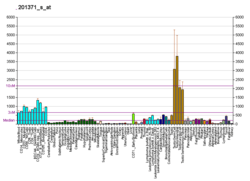CUL3
Cullin 3 is a protein that in humans is encoded by the CUL3 gene.[5][6][7]
Cullin 3 protein belongs to the family of cullins which in mammals contains eight proteins (Cullin 1, Cullin 2, Cullin 3, Cullin 4A, Cullin 4B, Cullin 5, Cullin 7 and Cullin 9).[8] Cullin proteins are an evolutionarily conserved family of proteins throughout yeast, plants and mammals.[9]
Protein function
Cullin 3 is a component of Cullin-RING E3 ubiquitin ligases complexes (CRLs) which are involved in protein ubiquitylation and represent a part of ubiquitin–proteasome system (UPS). Added ubiquitin moieties to the lysine residue by CRLs then target the protein for the proteasomal degradation.[10] Cullin-RING E3 ubiquitin ligases are involved in many cellular processes responsible for cell cycle regulation, stress response, protein trafficking, signal transduction, DNA replication, transcription, protein quality control, circadian clock and development.[11][12]
Deletion of CUL3 gene in mice causes embryonic lethality.[13]
Cullin 3-RING E3 ubiquitin ligases
Cullin 3-RING complex consists of Cullin 3 protein, RING-box protein 1 (RBX1), which recruits the ubiquitin-conjugating enzyme (E2), and a Bric-a-brac/Tramtrack/Broad (BTB) protein, a substrate recognition subunit. Cullin 3 protein is a core scaffold protein coordinating other components of the CRL complex.[14] Cullin 3-RING complexes can also dimerise via their BTB domains which lead to creation of two substrate receptors and two catalytic RING domains.[15]
Activation of the complex is regulated by the attachment of the ubiquitin-like protein NEDD8 to a conserved Lys residue in the cullin-homology domain, the process called neddylation.[16] Deneddylation is conducted by an eight-subunit CSN complex which mediates the cleavage of the isopeptidic bond between NEDD8 and cullin protein.[17] Another protein that interacts with cullin is CAND1 which binds to deneddylated form of cullin protein and disrupts the interaction between cullin and other subunits of the complex leading to inhibition of the E3 ubiquitin ligase activity.[18] Therefore, dynamic neddylation and deneddylation of cullin is important for regulation of CRL complex activity.[19]
Clinical significance
Familial hyperkalemic hypertension
Mutations in CUL3 gene are associated with Familial hyperkalemic hypertension disease. CRL complex containing Cullin 3 controls the activity of Na+ Cl− cotransporter (NCC) in the kidney by regulating the proteasomal degradation of With-no-lysine [K] kinases WNK1 and WNK4. It was shown that mutations in CUL3 gene lead to WNKs accumulation.[20] The abundance of these kinases leads to increased phosphorylation of NCC and its activation. As a consequence, Na+ reabsorption is increasing resulting in high blood pressure.[21]
Cancer
Deregulation of Cullin 3 expression level was observed in human cancers. It was shown that Cullin 3 is overexpressed in invasive cancers, and the protein expression level positively correlates with tumour stage. In breast cancer, the overexpression of Cullin 3 protein results in a decrease of Nrf2 protein level. This protein is a transcription factor regulating the expression of some detoxification and antioxidant enzymes. Another substrate of CRL complex is a candidate tumour suppressor protein RhoBTB2.[22]
Interactions
CUL3 has been shown to interact with:
References
- GRCh38: Ensembl release 89: ENSG00000036257 - Ensembl, May 2017
- GRCm38: Ensembl release 89: ENSMUSG00000004364 - Ensembl, May 2017
- "Human PubMed Reference:". National Center for Biotechnology Information, U.S. National Library of Medicine.
- "Mouse PubMed Reference:". National Center for Biotechnology Information, U.S. National Library of Medicine.
- Kipreos ET, Lander LE, Wing JP, He WW, Hedgecock EM (June 1996). "cul-1 is required for cell cycle exit in C. elegans and identifies a novel gene family". Cell. 85 (6): 829–39. doi:10.1016/S0092-8674(00)81267-2. PMID 8681378.
- Wimuttisuk W, Singer JD (March 2007). "The Cullin3 ubiquitin ligase functions as a Nedd8-bound heterodimer". Molecular Biology of the Cell. 18 (3): 899–909. doi:10.1091/mbc.E06-06-0542. PMC 1805106. PMID 17192413.
- "Entrez Gene: CUL3 cullin 3".
- Cheng J, Guo J, Wang Z, North BJ, Tao K, Dai X, Wei W (January 2018). "Functional analysis of Cullin 3 E3 ligases in tumorigenesis". Biochimica et Biophysica Acta (BBA) - Reviews on Cancer. 1869 (1): 11–28. doi:10.1016/j.bbcan.2017.11.001. PMC 7076836. PMID 29128526.
- Sarikas A, Hartmann T, Pan Z (2011). "The cullin protein family". Genome Biol. 12 (4): 220. doi:10.1186/gb-2011-12-4-220. PMC 3218854. PMID 21554755.
- Dubiel D, Bintig W, Kähne T, Dubiel W, Naumann M (August 2017). "Cul3 neddylation is crucial for gradual lipid droplet formation during adipogenesis". Biochimica et Biophysica Acta (BBA) - Molecular Cell Research. 1864 (8): 1405–1412. doi:10.1016/j.bbamcr.2017.05.009. PMID 28499918.
- Chen HY, Chen RH (2016). "Cullin 3 Ubiquitin Ligases in Cancer Biology: Functions and Therapeutic Implications". Frontiers in Oncology. 6: 113. doi:10.3389/fonc.2016.00113. PMC 4852199. PMID 27200299.
- Petroski MD, Deshaies RJ (January 2005). "Function and regulation of cullin-RING ubiquitin ligases" (PDF). Nature Reviews. Molecular Cell Biology. 6 (1): 9–20. doi:10.1038/nrm1547. PMID 15688063.
- Cheng J, Guo J, Wang Z, North BJ, Tao K, Dai X, Wei W (January 2018). "Functional analysis of Cullin 3 E3 ligases in tumorigenesis". Biochimica et Biophysica Acta (BBA) - Reviews on Cancer. 1869 (1): 11–28. doi:10.1016/j.bbcan.2017.11.001. PMC 7076836. PMID 29128526.
- Cheng J, Guo J, Wang Z, North BJ, Tao K, Dai X, Wei W (January 2018). "Functional analysis of Cullin 3 E3 ligases in tumorigenesis". Biochimica et Biophysica Acta (BBA) - Reviews on Cancer. 1869 (1): 11–28. doi:10.1016/j.bbcan.2017.11.001. PMC 7076836. PMID 29128526.
- Bulatov E, Ciulli A (May 2015). "Targeting Cullin-RING E3 ubiquitin ligases for drug discovery: structure, assembly and small-molecule modulation". The Biochemical Journal. 467 (3): 365–86. doi:10.1042/BJ20141450. PMC 4403949. PMID 25886174.
- Petroski MD, Deshaies RJ (January 2005). "Function and regulation of cullin-RING ubiquitin ligases" (PDF). Nature Reviews. Molecular Cell Biology. 6 (1): 9–20. doi:10.1038/nrm1547. PMID 15688063.
- Bulatov E, Ciulli A (May 2015). "Targeting Cullin-RING E3 ubiquitin ligases for drug discovery: structure, assembly and small-molecule modulation". The Biochemical Journal. 467 (3): 365–86. doi:10.1042/BJ20141450. PMC 4403949. PMID 25886174.
- Chew EH, Hagen T (June 2007). "Substrate-mediated regulation of cullin neddylation". The Journal of Biological Chemistry. 282 (23): 17032–40. doi:10.1074/jbc.M701153200. PMID 17439941.
- Soucy TA, Smith PG, Rolfe M (June 2009). "Targeting NEDD8-activated cullin-RING ligases for the treatment of cancer". Clinical Cancer Research. 15 (12): 3912–6. doi:10.1158/1078-0432.CCR-09-0343. PMID 19509147.
- Ferdaus MZ, McCormick JA (June 2016). "The CUL3/KLHL3-WNK-SPAK/OSR1 pathway as a target for antihypertensive therapy". American Journal of Physiology. Renal Physiology. 310 (11): F1389–96. doi:10.1152/ajprenal.00132.2016. PMC 4935775. PMID 27076645.
- Ferdaus MZ, McCormick JA (May 2018). "Mechanisms and controversies in mutant Cul3-mediated familial hyperkalemic hypertension". American Journal of Physiology. Renal Physiology. 314 (5): F915–F920. doi:10.1152/ajprenal.00593.2017. PMC 6031903. PMID 29361671.
- Haagenson KK, Tait L, Wang J, Shekhar MP, Polin L, Chen W, Wu GS (September 2012). "Cullin-3 protein expression levels correlate with breast cancer progression". Cancer Biology & Therapy. 13 (11): 1042–6. doi:10.4161/cbt.21046. PMC 3461811. PMID 22825334.
- Min KW, Hwang JW, Lee JS, Park Y, Tamura TA, Yoon JB (May 2003). "TIP120A associates with cullins and modulates ubiquitin ligase activity". The Journal of Biological Chemistry. 278 (18): 15905–10. doi:10.1074/jbc.M213070200. PMID 12609982.
- Singer JD, Gurian-West M, Clurman B, Roberts JM (September 1999). "Cullin-3 targets cyclin E for ubiquitination and controls S phase in mammalian cells". Genes & Development. 13 (18): 2375–87. doi:10.1101/gad.13.18.2375. PMC 317026. PMID 10500095.
- Kim AY, Bommeljé CC, Lee BE, Yonekawa Y, Choi L, Morris LG, Huang G, Kaufman A, Ryan RJ, Hao B, Ramanathan Y, Singh B (November 2008). "SCCRO (DCUN1D1) is an essential component of the E3 complex for neddylation". The Journal of Biological Chemistry. 283 (48): 33211–20. doi:10.1074/jbc.M804440200. PMC 2586271. PMID 18826954.
- Wang XJ, Sun Z, Chen W, Li Y, Villeneuve NF, Zhang DD (August 2008). "Activation of Nrf2 by arsenite and monomethylarsonous acid is independent of Keap1-C151: enhanced Keap1-Cul3 interaction". Toxicology and Applied Pharmacology. 230 (3): 383–9. doi:10.1016/j.taap.2008.03.003. PMC 2610481. PMID 18417180.
- Rachakonda G, Xiong Y, Sekhar KR, Stamer SL, Liebler DC, Freeman ML (March 2008). "Covalent modification at Cys151 dissociates the electrophile sensor Keap1 from the ubiquitin ligase CUL3". Chemical Research in Toxicology. 21 (3): 705–10. doi:10.1021/tx700302s. PMID 18251510.
- Rondou P, Haegeman G, Vanhoenacker P, Van Craenenbroeck K (April 2008). "BTB Protein KLHL12 targets the dopamine D4 receptor for ubiquitination by a Cul3-based E3 ligase". The Journal of Biological Chemistry. 283 (17): 11083–96. doi:10.1074/jbc.M708473200. PMC 2431063. PMID 18303015.
Further reading
- Andersson B, Wentland MA, Ricafrente JY, Liu W, Gibbs RA (April 1996). "A "double adaptor" method for improved shotgun library construction". Analytical Biochemistry. 236 (1): 107–13. doi:10.1006/abio.1996.0138. PMID 8619474.
- Yu W, Andersson B, Worley KC, Muzny DM, Ding Y, Liu W, Ricafrente JY, Wentland MA, Lennon G, Gibbs RA (April 1997). "Large-scale concatenation cDNA sequencing". Genome Research. 7 (4): 353–8. doi:10.1101/gr.7.4.353. PMC 139146. PMID 9110174.
- Michel JJ, Xiong Y (June 1998). "Human CUL-1, but not other cullin family members, selectively interacts with SKP1 to form a complex with SKP2 and cyclin A". Cell Growth & Differentiation. 9 (6): 435–49. PMID 9663463.
- Du M, Sansores-Garcia L, Zu Z, Wu KK (September 1998). "Cloning and expression analysis of a novel salicylate suppressible gene, Hs-CUL-3, a member of cullin/Cdc53 family". The Journal of Biological Chemistry. 273 (38): 24289–92. doi:10.1074/jbc.273.38.24289. PMID 9733711.
- Ishikawa K, Nagase T, Suyama M, Miyajima N, Tanaka A, Kotani H, Nomura N, Ohara O (June 1998). "Prediction of the coding sequences of unidentified human genes. X. The complete sequences of 100 new cDNA clones from brain which can code for large proteins in vitro". DNA Research. 5 (3): 169–76. doi:10.1093/dnares/5.3.169. PMID 9734811.
- Ohta T, Michel JJ, Schottelius AJ, Xiong Y (April 1999). "ROC1, a homolog of APC11, represents a family of cullin partners with an associated ubiquitin ligase activity". Molecular Cell. 3 (4): 535–41. doi:10.1016/S1097-2765(00)80482-7. PMID 10230407.
- Singer JD, Gurian-West M, Clurman B, Roberts JM (September 1999). "Cullin-3 targets cyclin E for ubiquitination and controls S phase in mammalian cells". Genes & Development. 13 (18): 2375–87. doi:10.1101/gad.13.18.2375. PMC 317026. PMID 10500095.
- Hori T, Osaka F, Chiba T, Miyamoto C, Okabayashi K, Shimbara N, Kato S, Tanaka K (November 1999). "Covalent modification of all members of human cullin family proteins by NEDD8". Oncogene. 18 (48): 6829–34. doi:10.1038/sj.onc.1203093. PMID 10597293.
- Maeda I, Ohta T, Koizumi H, Fukuda M (April 2001). "In vitro ubiquitination of cyclin D1 by ROC1-CUL1 and ROC1-CUL3". FEBS Letters. 494 (3): 181–5. doi:10.1016/S0014-5793(01)02343-2. PMID 11311237.
- Lyapina S, Cope G, Shevchenko A, Serino G, Tsuge T, Zhou C, Wolf DA, Wei N, Shevchenko A, Deshaies RJ (May 2001). "Promotion of NEDD-CUL1 conjugate cleavage by COP9 signalosome". Science. 292 (5520): 1382–5. doi:10.1126/science.1059780. PMID 11337588.
- Min KW, Hwang JW, Lee JS, Park Y, Tamura TA, Yoon JB (May 2003). "TIP120A associates with cullins and modulates ubiquitin ligase activity". The Journal of Biological Chemistry. 278 (18): 15905–10. doi:10.1074/jbc.M213070200. PMID 12609982.
- Kobayashi A, Kang MI, Okawa H, Ohtsuji M, Zenke Y, Chiba T, Igarashi K, Yamamoto M (August 2004). "Oxidative stress sensor Keap1 functions as an adaptor for Cul3-based E3 ligase to regulate proteasomal degradation of Nrf2". Molecular and Cellular Biology. 24 (16): 7130–9. doi:10.1128/MCB.24.16.7130-7139.2004. PMC 479737. PMID 15282312.
- Beausoleil SA, Jedrychowski M, Schwartz D, Elias JE, Villén J, Li J, Cohn MA, Cantley LC, Gygi SP (August 2004). "Large-scale characterization of HeLa cell nuclear phosphoproteins". Proceedings of the National Academy of Sciences of the United States of America. 101 (33): 12130–5. doi:10.1073/pnas.0404720101. PMC 514446. PMID 15302935.
- Rush J, Moritz A, Lee KA, Guo A, Goss VL, Spek EJ, Zhang H, Zha XM, Polakiewicz RD, Comb MJ (January 2005). "Immunoaffinity profiling of tyrosine phosphorylation in cancer cells". Nature Biotechnology. 23 (1): 94–101. doi:10.1038/nbt1046. PMID 15592455.
- Furukawa M, Xiong Y (January 2005). "BTB protein Keap1 targets antioxidant transcription factor Nrf2 for ubiquitination by the Cullin 3-Roc1 ligase". Molecular and Cellular Biology. 25 (1): 162–71. doi:10.1128/MCB.25.1.162-171.2005. PMC 538799. PMID 15601839.
- Hernández-Muñoz I, Lund AH, van der Stoop P, Boutsma E, Muijrers I, Verhoeven E, Nusinow DA, Panning B, Marahrens Y, van Lohuizen M (May 2005). "Stable X chromosome inactivation involves the PRC1 Polycomb complex and requires histone MACROH2A1 and the CULLIN3/SPOP ubiquitin E3 ligase". Proceedings of the National Academy of Sciences of the United States of America. 102 (21): 7635–40. doi:10.1073/pnas.0408918102. PMC 1140410. PMID 15897469.
- Lu L, Zhou ZM, Huang XY, Xu M, Yin LL, Wang H, Xu ZY, Sha JH (June 2005). "Identification and characterization of cul-3b, a novel hominine CUL-3 transcript variant". Asian Journal of Andrology. 7 (2): 205–11. doi:10.1111/j.1745-7262.2005.00024.x. PMID 15897978.
External links
- Human CUL3 genome location and CUL3 gene details page in the UCSC Genome Browser.








